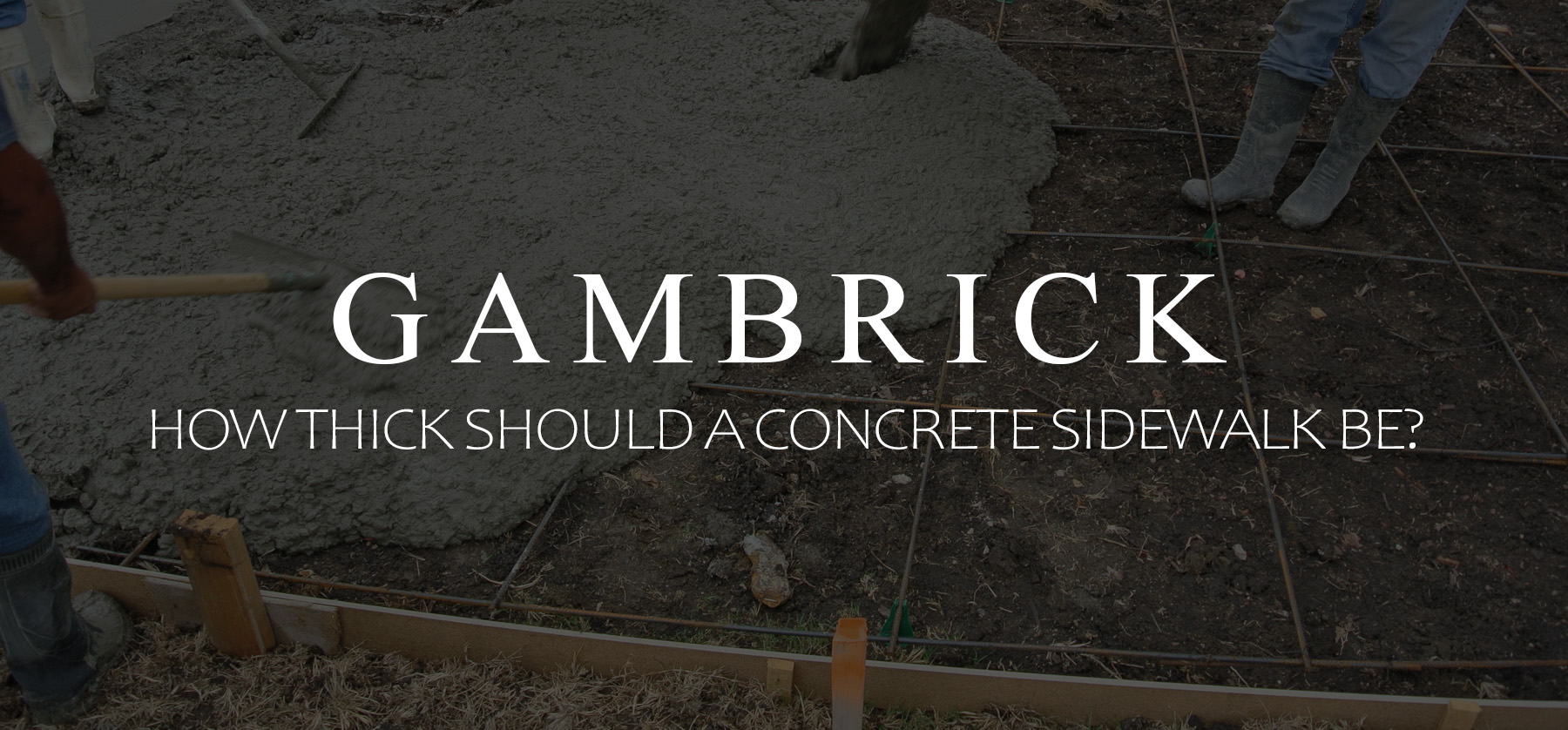
How Thick Should A Concrete Sidewalk Be?
Sidewalks should be at least 4″ to 6″ thick depending on the load they need to support and soil conditions. 4″ being the standard thickness. Almost every sidewalk and small slab floor for sheds we pour is 4″ thick. Although we do pour the edges a little bit thicker which helps prevent cracking. This commonly called a thickened edge. In areas where soil is strong with a well compacted base, 4″ is typically thick enough for everyday use like walking or biking. But if you live in an area with bad soil that can sink over time, I’d recommend pouring at least 6″ of concrete to prevent cracks. Then there’s reinforcing to consider. If your using rebar then 5″ to 6″ is probably your best bet. However, if your reinforcement is fiber, wire mesh, or Helix Micro Rebar, you can pour 4″.
Bikes, skateboards, strollers and scooters all easily glide smooth concrete sidewalks. Although sidewalks come in a variety of designs and sizes, they’re almost always made of concrete.
As a general rule, the best thickness for a concrete sidewalk is 4 inches for walkways and 5 to 6 inches if cars will be driving across it, or if it needs reinforcement for any reason. Such as a sidewalk in front of a concrete driveway or in places with bad soil or are prone to buckling. A sidewalk must be thick enough to bear the load and strong enough to resist cracks and erosion.
When it comes to building sidewalks and walkways, concrete is the most popular material we use. It’s affordable, looks great, is very strong and reliable. It’s also a very versatile building material that works in any climate and looks great on almost any style home.
How Thick Does A Concrete Sidewalk Need To Be?
The purpose of your sidewalk is an important factor that helps determine how thick it needs to be. A typical sidewalk is used for foot traffic and light weight equipment like bikes, scooters, skateboards and strollers. When properly built with the right strength concrete, a 4″ thick sidewalk provides more than enough strength for common everyday activities. However, if your sidewalk supports heavy vehicles or crosses a driveway, additional thickness will be required. A sidewalk that supports a motorized vehicle is generally poured 6 to 8 inches thick. That extra thickness helps prevent cracks and buckling.
In addition to a thicker slab, your sidewalk may also need reinforcement.
By taking into account the weight of the load each slab of concrete has to carry it’ll help determine how thick your concrete needs to be. Four inches for a standard sidewalk.
If a sidewalk crosses a driveway or other space where larger vehicles will be crossing like trucks, it is suggested to increase the thickness of your concrete to six to eight inches.
Size up as needed based on weight. In essence, the more the weight the thicker your concrete should be.
Reinforcing Sidewalks
Additional reinforcement can be added to the concrete which will increase it’s strength. While most concrete sidewalks do not require any extra support provided by reinforcing, if it is required, the thickness of the sidewalk will change based on the type of reinforcement you use.
Most of us have seen a concrete sidewalk that was cracking, buckling or both . This can happen from a number of reasons like bad soil, weight, or expansion and contraction due to temperature changes. Reinforcing the concrete can help prevent this.
If you need to reinforce your concrete, the most common ways are rebar, wire mesh, or an additive like Helix Micro Rebar or Fibers.
For only 4 inches of concrete, wire mesh or additives work best. But if you really want a strong slab then rebar is your best bet. This typically requires a slab of at least 6 – 8 inches.
You should vary your sidewalk thickness and reinforcement method based on two main factors. Soil conditions and the weight it will need to support.
Rebar
Most sidewalks don’t need to be reinforced with rebar.
Rebar is a steel bar used to reinforce and strengthen concrete. The name comes from the term reinforcement bar and is typically used in thicker concrete sidewalks expected to support heavy trucks or machinery. Rebar might also be used in sidewalks required to withstand impact on a regular basis. For your average sidewalk that crosses a driveway rebar will most likely be overkill if weight is the only issue.
General use sidewalks don’t benefit from the addition of rebar because they’re more than strong enough with it. Provided you build them right and use the correct strength concrete.
However, if you have bad soil which can settle under the sidewalk, rebar can help. When rebar is tied together inside a concrete sidewalk it helps bridge large voids and sinkholes which prevents cracks.
Rebar is thick and needs a few inches of concrete around it to work properly. Typically, rebar isn’t used in a 4 inch slab because the concrete isn’t thick enough.
Wire Mesh
Wire mesh is much thinner than rebar and can be used inside a thinner 4 inch slab. If your sidewalk needs some reinforcement then a thin layer of wire mush inside can be a great solution.
While wire mesh isn’t nearly as strong as rebar, it does strengthen a concrete sidewalk quite a bit, helps prevent cracks and buckling, and allows for a standard 4 inch thickness which saves money on concrete.
Wire mesh is also much cheaper than rebar and doesn’t take as much labor to install. It comes in sheets and only requires you to lay it into the middle of the sidewalk as you pour. It’s recommended that you tie the wire mesh sheets together as you go.
Can A Concrete Sidewalk Be Too Thick?
No. The structural issue concerning the thickness of your concrete sidewalk is regarding how thin it is. 4″ being the minimum. 5 inches is stringer than 4, 6 stronger than 5, etc. The thicker you go the stronger the sidewalk. But adding thickness has diminishing returns.
At some point you need to consider the cost of the concrete vs it’s intended use and strength requirement. 4″ is typically more than enough, in some very rare cases you may need to go to 6 or even 8, but I’ve never been asked to build a 10″ thick concrete sidewalk. Too thick just isn’t necessary. But too thin is a big problem.
Concrete is stronger when it’s thicker, but resources are wasted if the thickness exceeds what’s necessary for the structure’s performance.
Thin Sidewalks Are A Big Problem
I would never recommend pouring a concrete sidewalk or walkway under 3 inches. No matter how much reinforcement you add, when the slab is too thin it’ll be prone to cracking and buckling.
Thinner concrete changes with the surrounding temperature faster than thicker concrete does. This results in buckling and cracks. Thin concrete also cracks much easier under even standard loads and impacts. Especially if there’s a void underneath.
Be Consistent
An important part of building a good sidewalk is being consistent. The concrete needs to be the right strength throughout the sidewalk with no weak spots.This means a consistent mix and pour. This is especially important when the sidewalk is 4 inches because there’s no room for error.
Make sure when pouring a 4 inch thick concrete sidewalk that it’s an even 4 inch thick throughout. Don’t allow any areas of the base to be higher because in that spot your sidewalk will be too thin and could crack. This is a common problem we see all the time while doing sidewalk repairs.
When your pouring a sidewalk thicker than 4 inches there’s some wiggle room. For example, if you’re building a 5 inch thick sidewalk and a section of the base is off 1/2 an inch, your still 4 1/2 inches thick which is generally fine. However, if your sidewalk was 4 inches thick and a section is off 1/2 an inch, that section will be too thin and prone to cracking.
Sidewalks typically follow the level of the earth. Soil is a major part of the support system for concrete. The weight that’s on top of the concrete is transferred to the soil. The base has to give uniform support to the concrete, or it may cause cracks.
A Good Base
Making sure your concrete is the right thickness has a lot to do with the base.
Generally the sidewalk area is dug out and a gravel base is poured. The base is usually four to eight inches thick and must be even and packed down before you begin pouring.
The surface of a concrete sidewalk is totally flat which means the base beneath it also needs to be flat. For a 4″ thick sidewalk, the base needs to be exactly 4″ below the surface of the finished concrete. This is why an even and compacted base is so important. There isn’t much room for error when your pouring the minimum thickness.
High spots and low spots in the base create different thicknesses within the sidewalk. This changes how loads are distributed and how temperatures are maintained within the concrete which leads to uneven expansion and contraction. All this basically means your sidewalk will be more prone to cracks if the thickness isn’t even.
Pro Tip: Don’t pour concrete directly onto grass or sod. The reason is that organic material decays which can cause an uneven base and cracks.
Other Facts
When it comes to determining the right thickness for your concrete sidewalk there’s more to consider than just weight. Some other very important considerations are the earth and soil below and the temperatures it’ll be subjected too.
Here are some short facts that might be helpful.
- A sidewalk that’s too thick is a waste of money, but one that’s too thin will be prone to cracks. Make sure your sidewalk thickness is correct for what you need.
- Adding 1 more inch to a 4 inch thick concrete sidewalk can increase the load bearing capacity by nearly 50 percent. If you think you need more strength, it doesn’t take much additional concrete to get it.
- Your sidewalks thickness should be uniform, but slanting the sidewalk to allow for proper drainage is fine.
- Concrete for a sidewalk should generally be around 3500 – 4000 psi.
- Make sure to keep your slabs thickness even. High or low spots can weaken the sidewalk and cause cracks.
- Uneven thickness can also cause buckling because of uneven expansion and contraction pressures.
- If your pouring a 4″ thick concrete sidewalk and want more strength consider adding wire mesh, Helix Micro Rebar or Fiber. Traditional rebar will be too thick.
- Use rebar in bad soil. If your area is prone to sink holes and voids below the sidewalk, then opt for a thicker slab and rebar. Rebar will hold the sidewalk together and span voids better than concrete alone.
Summary: How Thick Should A Concrete Slab Be?
Sidewalks should be at least 4″ to 6″ thick depending on the load they need to support and soil conditions. 4″ being the overwhelming standard. Almost every sidewalk and small slab we pour is 4″ thick overall. Although we do pour the edges a little bit thicker which helps prevent cracking. This commonly called a thickened edge. In areas where soil is strong with a well compacted base, 4″ is typically thick enough for everyday use like walking or biking. But it you live in an area with bad soil that can sink over time, I’d recommend pouring at least 6″ of concrete to prevent cracks. Then there’s reinforcing to consider. If your using rebar or wire mesh then 6″ is probably your best bet. However, if your reinforcement is fiber or Helix Micro Rebar, you can pour 4″.
Bikes, skateboards, strollers and scooters all easily glide smooth concrete sidewalks. Although sidewalks come in a variety of designs and sizes, they’re almost always made of concrete.
As a general rule, the best thickness for a concrete sidewalk is 4 inches for walkways and 6 inches if cars will be driving across it or if it needs reinforcement for any reason. Such as a sidewalk in front of a driveway or in places with bad soil or are prone to buckling. A sidewalk must be thick enough to bear the load and strong enough to resist cracks and erosion.
When it comes to building sidewalks and walkways, concrete is the most popular material we use. It’s affordable, looks great, is very strong and reliable. It’s also a very versatile building material that works in any climate and looks great on almost any style home.
If you have any questions or comments e-mail us any time. We’d love to hear from you.

John Mazzuca | About | More Posts |
Custom Home Builder
John Mazzuca is a custom home designer and builder at Gambrick with over 25 years experience in the construction industry. John has designed, built and/or remodeled hundreds of homes, small buildings, and commercial projects. He writes about business, real estate, home building, and household electronics. His work has been featured in Fox Business, Better Homes & Garden, House Beautiful, and more.




















